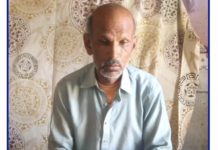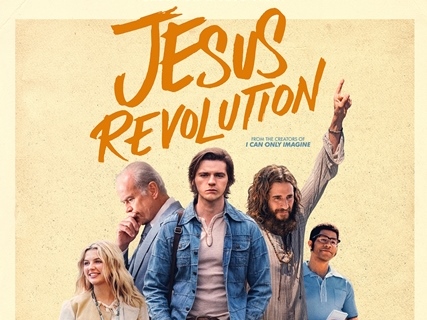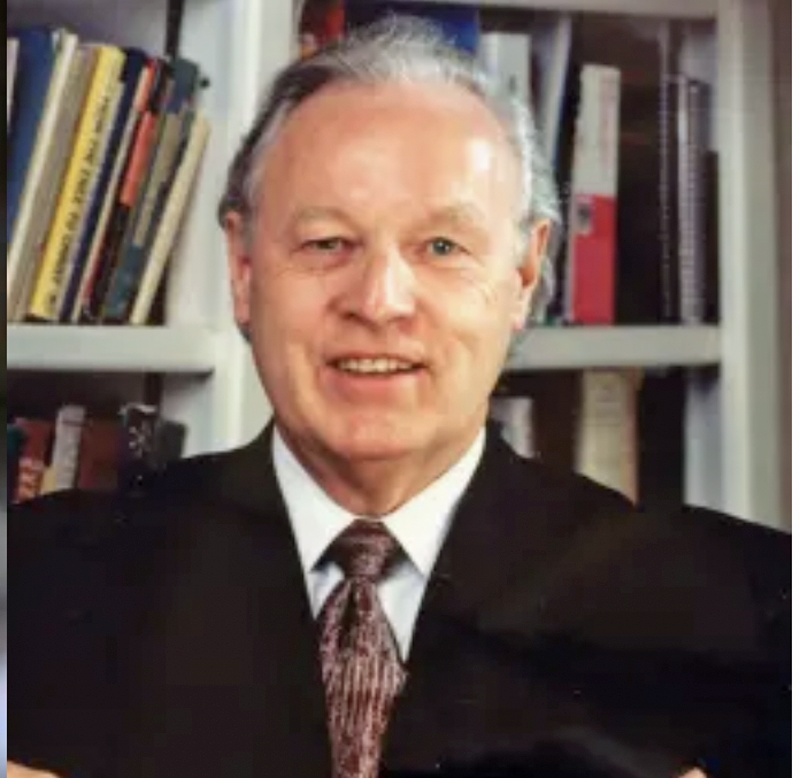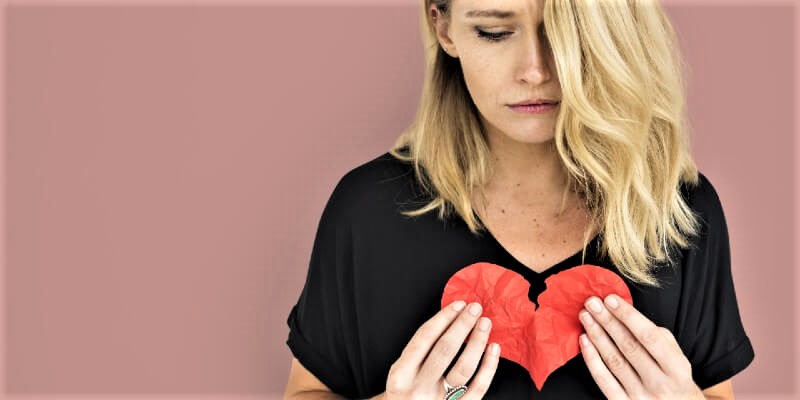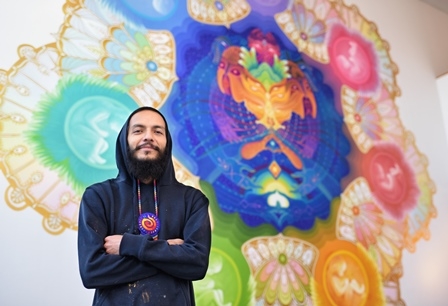
By Brian Nixon, Special to ASSIST News Service
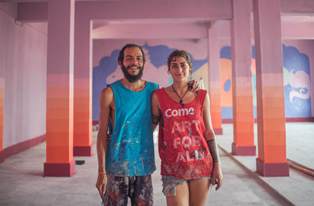 ALBUQUERUQE, NEW MEXICO (ANS — January 28, 2018) — While walking down Central Avenue (historic Route 66) with my family, we poked our heads into 516 ARTS, looking through the window in anticipation for the new exhibit — The US-Mexico Border: Place, Imagination, and Possibility. As one of the leading arts-centered organizations in the New Mexico, 516 ARTS is a place our family frequents regularly to refresh our vision on life and renew our love of creativity.
ALBUQUERUQE, NEW MEXICO (ANS — January 28, 2018) — While walking down Central Avenue (historic Route 66) with my family, we poked our heads into 516 ARTS, looking through the window in anticipation for the new exhibit — The US-Mexico Border: Place, Imagination, and Possibility. As one of the leading arts-centered organizations in the New Mexico, 516 ARTS is a place our family frequents regularly to refresh our vision on life and renew our love of creativity.
But on this quick stop, something fun happened. Outside of 516 ARTS a man was standing. He had on paint-splattered pants, his hair tussled and beard unkempt. I introduced myself. It turned out that he was artist Curiot Tlalpazotl (Favio Martinez), taking a break from working on his mural for the opening exhibit. After some small talk, I asked Curiot about his process of creation. He replied that some of his works are largely improvisational, with no set drawings; he begins with an idea in his head and then paints in freestyle form. I was impressed. But with no set imagery on the wall, it was difficult to tell where his mural was going. A return visit was in store.
Born in Michoacán, Mexico, Curiot grew up in the United States, moving back to Mexico to attend college, receiving a degree in art from Universidad Michoacána [1]. In a 516 ARTS publication, Curiot stated, “Growing up in the States sort of gave me a diluted Mexican culture, I had no clue what I was missing out on until I moved back 10 years ago… The bright colors, folklore, ancient cultures and the beautiful handcrafts are some of the things that I embraced and which influence my work deeply.”
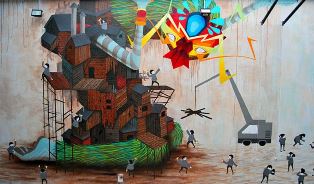 Curiot is known for his mural artwork, blending geometric shapes with human and animal forms, intermixed with allusions to various Central American motifs: Day of the Dead, tribal, religious, floral, and the like. His work is imaginative, rooted in symbolic gesturing, vibrant colors, and surreal scenery.
Curiot is known for his mural artwork, blending geometric shapes with human and animal forms, intermixed with allusions to various Central American motifs: Day of the Dead, tribal, religious, floral, and the like. His work is imaginative, rooted in symbolic gesturing, vibrant colors, and surreal scenery.
Meeting Curiot outside 516 ARTS fascinated me enough to attend a discussion about the mural. It happened one week after our initial meeting. And once again, Curiot was outside, waiting to chat with people who were gathering inside. “I get a little nervous talking in front of people,” he confided. You’ll do great, I reply—just go and tell them what you do. We then begin to discuss—of all things—some common experiences we share.
“My family moved to Costa Mesa, California, when I was young,” Curiot stated. “I did most of my upbringing in Orange County, California. I graduated from Costa Mesa High School.” Being that I, too, lived in Costa Mesa, we spent a few minutes reminiscing about the city.
I asked how he garnered a love of art, and he replied: “It began with street art in California, graffiti and the like. It expanded from there, eventually leading me back to Mexico to get a degree in art.”
Have you found a permanent home in Mexico or do you get back to Orange County much, I ask? “Over the past two to three years I’ve been traveling. I just got back from Mumbai, India. I was part of an installation project, working with a Uruguayan artist — Romina Romanelli,” he said. We painted a large mural together. I was in India for a few months [2].”
“And just the past couple of months,” he continued, “I’ve been in Mexico City working on a mural, part of the Sea Walls movement [3]. I need to fly back to Mexico after my time in New Mexico to finish up the mural,” he says with a chuckle. “To say the least, I’ve been busy.”
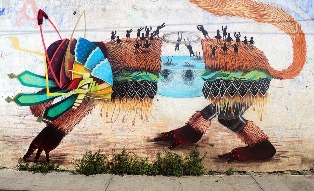 Does it bother you that some of your murals will be covered up; that your creative work has a shelf life, I ask? “No, it’s part of the life of a muralist,” he replies. “Many of the murals will last a long time. But after a while, graffiti, or complete cover up, happens. I suppose it’s part of the process; creation, re-creation. I take pictures of all the work, however. So there is documentation.”
Does it bother you that some of your murals will be covered up; that your creative work has a shelf life, I ask? “No, it’s part of the life of a muralist,” he replies. “Many of the murals will last a long time. But after a while, graffiti, or complete cover up, happens. I suppose it’s part of the process; creation, re-creation. I take pictures of all the work, however. So there is documentation.”
We walked inside to look at his recently completed mural.
What do you call it, I ask? “I call it Unity,” he said. Can you explain some of the meaning — I continue, fascinated by the symbolic elements of the work? “The center imagery represents the sprit of nature,” he states. “In the middle you’ll find Central American religious motifs. And then around the central imagery are babies in womb-like bubbles. The basic idea is that humans are born from nature, that all of humanity is connected.”
Sounds almost metaphysical, I reply. “Yeah, I’ve been on a kind of spiritual journey,” he replies. And what have you discovered, I prod? “I’m still learning and listening,” he states. I appreciate the honesty of his answer.
Seeing that other people want to chat with Curiot, we depart ways. I then have an engaging conversation with 516 ARTS Executive Director, Suzanne Sbarge, about the mural and mission of 516 ARTS—a new emphasis on 516 being a place where contemporary art is for everyone. Suzanne explains to me that 516 ARTS invited Curiot to create a temporary mural on the 25-foot wall, addressing the subject of the US-Mexico border.
I ask Suzanne about the short shelf life of Curiot’s mural.
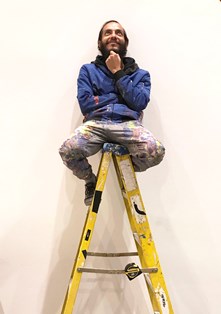 “It is a little unsettling,” Suzanne, confesses. “We tried other options for a more permanent solution, to no effect. But what we decided upon is that we’ll have high quality posters made, signed by Curiot. They’ll be available for purchase at 516 ARTS. All proceeds go to our ongoing mission to be an active partner in Albuquerque’s cultural landscape. And to make up for the short life of Unity, Curiot is working on a semi-permanent installation mural at the front of the building. He just began it today.” Suzanne points to a front corner of the museum. I look—seeing the ladder and scaffolding platform, thinking I can’t wait to see the finished product.
“It is a little unsettling,” Suzanne, confesses. “We tried other options for a more permanent solution, to no effect. But what we decided upon is that we’ll have high quality posters made, signed by Curiot. They’ll be available for purchase at 516 ARTS. All proceeds go to our ongoing mission to be an active partner in Albuquerque’s cultural landscape. And to make up for the short life of Unity, Curiot is working on a semi-permanent installation mural at the front of the building. He just began it today.” Suzanne points to a front corner of the museum. I look—seeing the ladder and scaffolding platform, thinking I can’t wait to see the finished product.
We both stare at Unity, marveling that no sketches or preliminary renderings were made; Unity found life in an improvisatory manner, the product of one man’s mind in a moment of time.
Both discussions solidified my respect for the need of quality art within a city, something 516 ARTS is accomplishing with great resolve. And through my conversation with Curiot I garnered greater appreciation for the profound nature mural artwork has on a community. For me, Curiot Tlalpazotl stands in a long lineage of muralists whose artwork has continued an ongoing conversation between a civilization and its citizens, communicating in a language this is open, engaging, and attentive, helping the constituents of a community appreciate what it means to be human.
Unity will be on view at 516 ARTS through April 14th, 2018. For more information about the exhibit or 516 ARTS, visit http://516arts.org/.
To learn more about the US-Mexico Border: Place, Imagination, and Possibility exhibit at 516 Arts, click here: http://www.516arts.org/index.php/programs-link/55-exhibition/577-us-mexico-border.
Photo captions: 1) Curiot with artist Romina Romanelli in India. 2) Mural, Pasaje-de-Gorathma, by Curiot. 3) Mural #7. 4) Curiot Tlalpazotl. (Photo: Sergio Salvador). 5) Brian Nixon.
About the writer: Brian Nixon is a writer, artist, musician, and educator. He’s a graduate of California State University, Stanislaus (BA), Veritas Seminary (MA), and is a Fellow at Oxford Graduate School (D.Phil.). To learn more, click here: http://en.wikipedia.org/wiki/Brian_Nixon
** You may republish this and any of our ANS stories with attribution to the ASSIST News Service (www.assistnews.net). Please also tell your friends and colleagues that they too can have a free subscription to our news service by signing up there.


